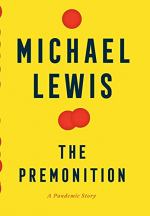|
This section contains 674 words (approx. 2 pages at 400 words per page) |

|
The Premonition Summary & Study Guide Description
The Premonition Summary & Study Guide includes comprehensive information and analysis to help you understand the book. This study guide contains the following sections:
This detailed literature summary also contains Topics for Discussion on The Premonition by Michael Lewis (author).
The following version of this book was used to create the guide: Lewis, Michael. The Premonition. W. W. Norton & Company, 2021.
Michael Lewis's text The Premonition is a work of nonfiction. Although written by Lewis, Lewis's first person point of view largely remains tangential to the text's explorations. Throughout The Premonition, Lewis employs both the past and present tense and embraces some formal experimentation. The following summary assumes a similar mode of explanation.
In his introduction, Lewis describes his reasons for writing The Premonition. As with all of his previous publications, Lewis hopes that his research will uncover a central story. Although he will not intrude upon his research subjects' narratives in the pages that follow, he has formed opinions from his research. He believes that at its heart, The Premonition is about the power of story and the ways in which curious minds might deliver a nation from crisis.
In 2003, Laura Glass asked her scientist father, Bob Glass, for help with her science fair project. She wanted to create a model that would help her study the spread of disease within a large population. Although working nearly 20 years prior to the 2020 COVID-19 pandemic, Laura and Bob's work seemed to predict the events of the future.
When Charity Dean was offered the position of deputy health officer, she accepted the job with enthusiasm. She knew it would not pay well and would require much from her, but believed the position might help her to create change. Throughout her first years in the position, Charity overcame many challenges, proving herself more fierce than expected.
After finishing medical school, Carter Mecher began working in the ICU. The work helped him remember the fragility and sanctity of human life. He did not see his patients as inanimate, dying subjects, but as stories. Hearing their accounts from the past allowed Carter to identify with them. After leaving the ICU, he began working for the Department of Veterans Affairs. He took a similar approach to his work in this context.
In 2005, George W. Bush invoked Rajeev Venkayya's help to create a national pandemic response plan. Rajeev was given permission to hire several people to work with him. The first of his hires was a former doctor named Richard Hatchett. Richard had previously given up medical work to work in government spheres. He was excited by Rajeev's task, and eagerly joined the team. Throughout his life, Richard had been searching for a higher calling. After surviving a childhood accident, he felt that he had been saved in order to accomplish some greater feat. While working with the White House team, he realized this new work was the purpose of his life. Then Rajeev hired Carter, with whom Richard got along. Though the men had different backgrounds and opinions, they respected one another.
Carter and Richard went on to write a paper together. The paper considered the 1918 flu pandemic as a means of understanding and predicting future viral threats.
At the start of the 2020 COVID-19 pandemic, the Chief Medical Officer of the Department of Homeland Security, Duane Caneva, contacted Charity. He told her that he and a group of experts were developing a pandemic response plan without official government backing. He invited her to join. Charity was inspired by his bravery. She was even more delighted when she read Carter and Richard's paper and heard about their particular approaches to the pandemic. Over the months following, the team, called Red Dawn, developed a national containment plan. Charity's hope for the plan was that it might compel the American people to act out of care for one another.
Although much of Carter's, Richard's, and Charity's work went unnoticed or unrecognized at the national level, their innate bravery, fearlessness, and devotion to the American people helped the country contain the coronavirus. Reflecting back on the first year of the pandemic, Charity saw it as a gift from Mother Nature. The environment had shown the American people that they needed to be better prepared and that they needed to learn to work together.
Read more from the Study Guide
|
This section contains 674 words (approx. 2 pages at 400 words per page) |

|



